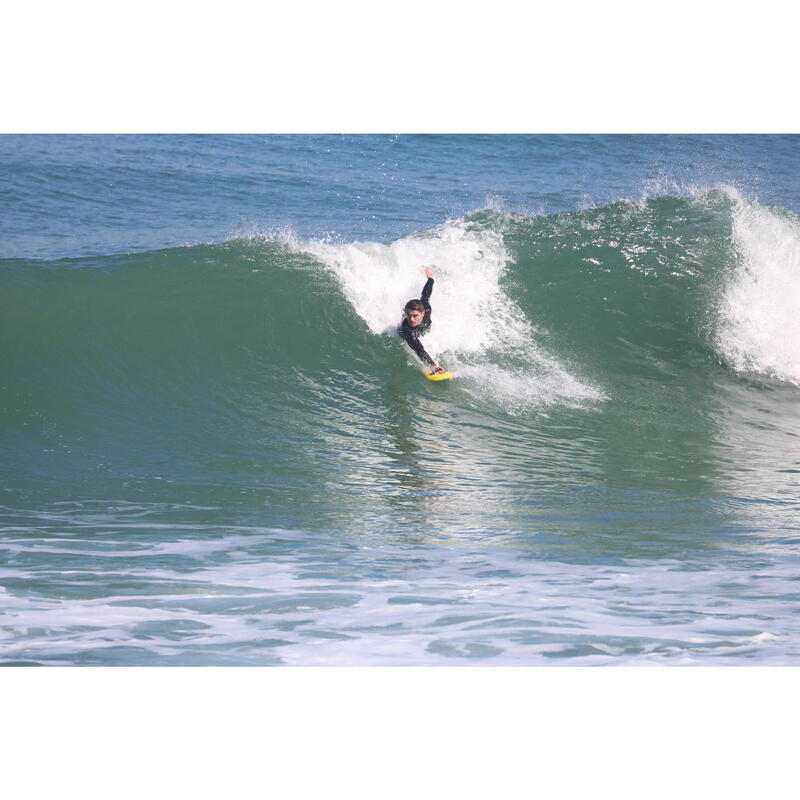What is bodysurfing?
Bodysurfing involves surfing waves with your body. It is practiced with a pair of fins and a handplane (only one handplane is needed).
What is a handplane?
A handplane (also known as a bodysurfer's board or handboard) is a small board that sits under the bodysurfer's front hand, making it easier to glide and steer in the wave.
This handplane uses soft, lightweight materials to increase its ability to float and therefore lighten the bodysurfer to catch waves more easily.
Its rounded shape makes it easier to glide and steer.
Its adjustable strap makes it suitable for all hand sizes.
How to use a bodysurfing handplane: Moving and positioning in the water.
Start by putting your front hand into the handplane strap, adjusting it if necessary. Your propulsion will be provided mainly by your fins. As you move through the water, you can use the handplane for crawl strokes, or lean on it with your arms outstretched.
How to use a bodysurfing handplane: Catch and ride a wave.
To catch a wave, paddle energetically with your feet/feet towards the beach, body sheathed, arms stretched forward, with your hands resting on the handplane.
As you catch the wave, orient your whole body in the direction of the break (right or left). You can then choose to keep both hands on the handplane or move your back arm along your body, which should remain as sheathed as possible.
Which fins should you choose for bodysurfing?
Most bodyboard fins are suitable for bodysurfing. For the best comfort/propulsion ratio, we recommend 500 OLAIAN bodyboard fins. These have the special feature of being symmetrical, to give your knees a better workout when you're finning. They also feature fin leashes, a very important accessory if you don't want to lose them.
Safety rules and behaviour in the water - Part 1.
Bodysurfing is a fantastic sport that requires certain fundamental rules to be respected for everyone's enjoyment and safety.
1- Find out about and observe the characteristics of the spot: current, rocks, tidal influence, wave size, number of people in the water...
2- Don't overestimate your level, and prefer an easier spot if conditions exceed your abilities.
3- Practice with suitable equipment: fins and handplane in good condition, suitable neoprene wetsuit.
Safety rules and behavior in the water - Part 2.
4- Respect the rules of priority on the wave: priority to whoever is closest to the breaker.
5- Go around the breaker zone when you go up to the peak.
6- Use fins. Otherwise, we recommend that you practice in the safe swimming area.
7- Do not practice in waves that break directly on the sand.
8- Protect your head in the event of a fall, by trying to fall on your side (never head first).
9- Practice with others.
Do not leave exposed to extreme heat.
When not in use, take care not to expose your handplane to sunlight or temperatures >40°C. So protect your handplane in a bag, under an umbrella, in the shade or under a light towel, to prevent it from overheating. In particular, avoid leaving it in a car in direct sunlight. Exposure to excessive heat can result in blisters, bubbles or even deformation of the handplane.
RADBUG
RADBUG is the Decathlon brand dedicated to bodyboarding and bodysurfing.
Our raison d'être is to bring the incredible sensations of bodyboarding and bodysurfing to as many people as possible.
The sensation of gliding over the wave is pure, intoxicating and addictive.
Our mission is to enable everyone to learn and progress by offering easy, daring products for ever greater pleasure.





